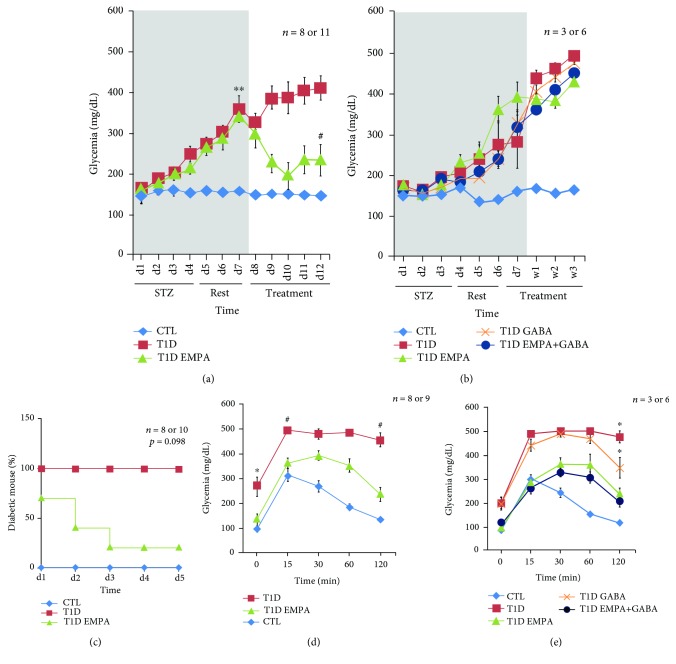Figure 1.
Glycemia evolution and the effect of empagliflozin, GABA, and their combination on the homeostasis of glucose. Empagliflozin treatment decreases glucose level and diabetic mice percentage. Long-duration treatments of empagliflozin and GABA improve glucose tolerance of diabetic mice. (a and b) The grey area corresponds to the STZ injection period (four days) and the rest period (three days). (a) Asterisks (∗∗) show a significant difference between the CTL group and the T1D group (p = 0.002, ANOVA-Welch) and between the CTL group and the T1D EMPA group (p = 0.004, ANOVA-Welch). Hashtag (#) shows a significant difference between the T1D group and the T1D EMPA group (p = 0.032, Kruskal-Wallis). (b) Statistics performed using a Kruskal-Wallis test. (a) and (b) correspond to protocols #1 and #2, respectively. The letters d and w correspond to day and week, respectively. (c) For protocol #1, the Kaplan-Meyer curves represent the percentage of diabetic mice from the first day of treatment to the day of sacrifice. Statistics performed using a log-rank test. Mice were considered diabetic when blood glucose exceeded 200 mg/dL for two consecutive days. (d and e) An intraperitoneal glucose tolerance test (IPGTT) was performed at the end of the treatments. Blood glucose was measured at different times after a 20% glucose injection in mice. (d) Protocol #1: asterisk (∗) shows a significant difference (p < 0.011) between the CTL group and the T1D group. Hashtag (#) shows a significant difference (p < 0.001 and p < 0.05, respectively) between the CTL and T1D EMPA groups and the T1D group. (e) Protocol #2: asterisk (∗) shows a significant difference (p ≤ 0.05) between the CTL, T1D EMPA, and T1D EMPA+GABA groups and the T1D and T1D GABA groups. (d and e) Statistical analyses were performed using a Kruskal-Wallis test. Glycemia was monitored for control mice (CTL, diamond blue curve); untreated diabetic mice (T1D, square red curve); and diabetic mice treated with empagliflozin (T1D EMPA, triangle green curve), GABA (T1D GABA, cross orange curve), or empagliflozin and GABA (T1D EMPA+GABA, round marine blue curve). The bars represent the standard error of the mean. For each protocol, the number of mice per group is indicated (n = 8 or 11, n = 8 or 10, n = 8 or 9, and n = 3 or 6).

